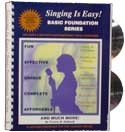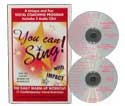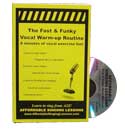|
FREE SINGING LESSONS - ARTICLES
|
TONE
PLACEMENT
Taking the abstract idea of tone placement and replacing it
with specific instructions for improvement and understanding.
(c) Yvonne DeBandi 2003
Say these syllables with slightly exaggerated mouth movements: EE -
EH - AH - OH - OO.
Now do it again, but this time imagine that there is an "X" that
moves in your mouth. The first syllable, "EE" finds its central
balance point at the very front of your mouth and teeth. That "X"
then moves in a line to the back of your mouth so that the "OO"
position has an "X" that rests in the very back.
Stating the concept in this fashion gives us FIVE different mouth
positions or placements that we can use and discuss easily. Say them
again. "EE, EH, AH, OH, OO"
Now the ideal position for most singing is the "Ah" position, or the
central "X". In addition, you will want to think about what I
call, "Apple Ah". This means your "ah" should be placed and stated
as if you were about to bite into a nice medium-sized apple. Say it
several times practicing the position, "ah" "ah" "ah".
"Apple
Ah" works better because of how the cheekbones become
involved in the action. Without the apple idea, many students
believe they are in the "Ah" position when they
are actually more in the "Oh" position. Don't allow
yourself to fall in this trap! Really visualize the apple.
To
further emphasize the position/placement idea, say the word
"moon." Generally speaking, most people place it
in the back "OO" position. That means, if I had
to put an "X" at the center place of where that
word sits in my mouth, it would be the very back. If it doesn't
fall there naturally, try to place it there. Say it again,
"moon."
Now work your way back to "Apple Ah."
Say, "EE, EH, AH". Again. "EE, EH, AH." Now say the word "moon"
again, but in that wonderful "Apple Ah" position. See the difference? Once you understand this concept you can easily apply it to any
phrase you are singing. Now let's make sure you understand WHY we
want to do this and why it is so important.
Singing
in the "Oh" or "Oo" position leads to
vocal fatigue or hoarseness. This position simply makes your
vocal cords and what many of us call your voice organ (meaning
all of the muscles, membranes, cartilages, everything involved
with voice production, etc.) work too hard. This position
also leads to a hooty or covered sound. Some young singers
like to use this placement because it makes them sound older.
Unfortunately, it also sets them up for vocal problems and
frustrating moments as an adult singer.
Singing in the "EE" or "EH" position leads to a very bright, nasal
and cutting sound that lacks good tone. It can also cause mouth and
facial tension. So we want to use these positions to our advantage
when needed, but we do not want to sing with this placement most of
the time.
Singing in the "Apple Ah" position is healthy and promotes balanced
use of the oral cavity. Learn to raise your soft palate (like you
have the big side of an egg in the back of your mouth, or like what
happens when you yawn) while you sing in the "Apple Ah" position and
you will get a nice balanced sound. Be careful. Many people try the
analogy of the egg and find their placement falls back to the "Oh"
position. Just practice, after a few practice sessions with
consistent repetition and you will surprise yourself at how easy it
is.
Remember that everything in singing is about balance. If you have a
good foundation of vocal mechanics, which includes tone placement as
described above, you can learn to utilize other placements for
stylistic effects. To clarify, if you can stay in the "Ah" position
as your "default" position and just bounce to the other identified
placements (EE, EH, OH, OO) for stylistic effects when needed, you
will not suffer the fatigue and hoarseness associated with vocal
abuse.
Finally, if you have good breath control and support, are singing in
the "Apple Ah" position but still do not like the sound of your
voice, your issue lies with how you are creating RESONANCE and
utilizing your resonating devices. And that .... is another lesson.
Training
products created by
Coach Yvonne DeBandi.
Books, Interactive Downloads and CDRoms available!
Click HERE
to learn more. |
 |
 |
 |
|
|



